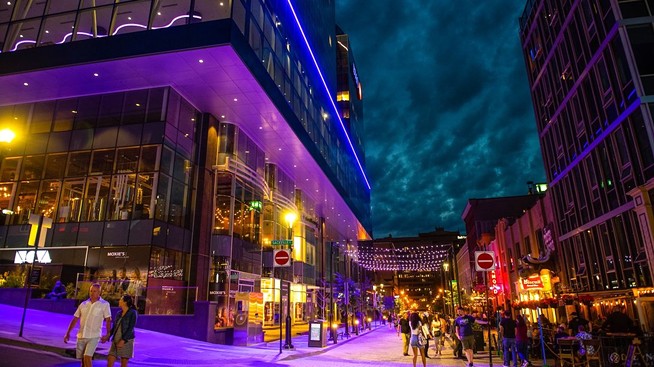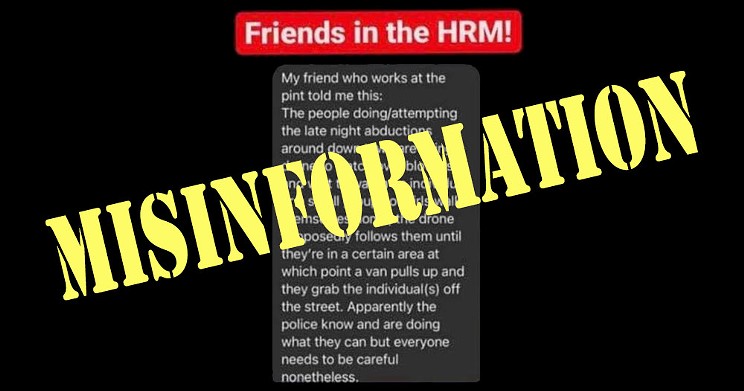A highly shareable, highly misleading post making the social media rounds in Halifax would have you believe that the downtown bar scene is under attack from a sophisticated tactical squad of people on a mission to grab women off the street. The post first appeared in early September. “Friends in the HRM!” it begins. “My friend who works at the pint told me this.”
Supposedly the “people doing/attempting the late night abductions” downtown use a drone to identify vulnerable women, “an individual or a small groups of girls.” The drone pilot tracks the target until “a van pulls up and they grab the individual(s) off the street.” On a busy night downtown, women are—according to this post—disappearing into thin air.
It doesn’t say what happens to these women, but Halifax does have the highest per capita sex trafficking rate in the country, and the mention of “girls” specifically (one common rumour is that sex-trafficking victims are only women) brings sexual exploitation to top of mind.
“Apparently the police know and are doing what they can,” reads the last line of the post, which is written to look like a message sent between friends, “but everyone needs to be careful nonetheless.”
One example of the post on Facebook tags The Pint, the Argyle Street pub credited as the source of information in the post, and the Halifax police. On a since-deleted Facebook post from September 11, there were over 1,000 shares. The woman who posted it took it down not out of concern about spreading misinformation, but because she was getting too many “weird ads for Facebook and Instagram.” She says it originally came from a re-sharing account on Instagram, but couldn’t recall which one.
In an Instagram message to The Coast, The Pint says it “had some staff leave and be followed by a drone on blowers street a few weeks ago that followed them down to the parking garage at the bottom of blowers street,” and “had staff seen blank vans parked around pizza corner.”
The Coast reached out to Halifax Regional Police for comment, and public information officer John MacLeod says police "haven't had reports or seen anything to believe its credibility."
“If people are running around looking for gangs of men in vans using drones, they will lower their guard when someone is innocently commenting on Instagram posts or grooming in more likely ways.”
tweet this
Of course, abductions and exploitation don’t always get reported, so The Coast contacted the YWCA in Halifax, which has its own Trafficking and Exploitation Service System (TESS) Partnership, for more info.
“On its face, it seems like a fake post, given the elaborate description of a strategic, high tech, abduction plot,” says Charlene Gagnon in an email. “The reality is that off-the-street abductions involving vans happen way less than Facebook would have you believe sometimes.”
So how do people get drawn into human trafficking? Miia Suokonautio, executive director of the YWCA, takes a look at the viral image on her phone and says, “It doesn't, overwhelmingly, look like this. It looks like grooming, long grooming, taking advantage. A lot of people don't even identify themselves as being exploited because they say, ‘this is my boyfriend.’”
Suokonautio doesn’t rule out the street abductions as a possibility, but thinks that would be the exception to the norm. “If we focus ourselves on the exception, we will lose the bigger piece,” she says. “What we do know is that racialized and Indigenous people are overrepresented. We know that youth are the most vulnerable.”
Other risk factors are involvement in the child welfare system, poverty and rural isolation. Statistics from 2018 say 30 percent of people being trafficked are under age 18. Real human trafficking isn’t easy to uncover, and has to meet specific conditions to lay a charge under Canada’s criminal code. What’s broader and more common is what the YWCA calls “commercial sexual exploitation.”
“I’m the building super or I’m the landlord, you’re behind on rent. You give me sex and you can stay here. Or you’re living with addiction and have sex for drugs. Those are different types of sexual exploitation,” Suokonautio says. “It also includes things like the creation of pornography against people’s will.”
The “abductions” post doesn’t tell people to watch out for any of that.
“I feel like it’s this weird intersection between stranger danger, the titillating, sensationalist nature of sex and a heightened discourse around human trafficking, like social media often will do,” says Suokonautio. “And what it does is it drives clicks, it drives likes. But for us, more alarming is that it draws away from what it actually looks like. And it’s really a distraction.”
Why would someone post this in the first place? For an answer, Suokonautio looks to the Latin phrase cui bono—who benefits?
“Spreading fear and misinformation, trying to go viral, perhaps even misdirecting people away from the real threats that tend to happen online,” she says. “If people are running around looking for gangs of men in vans using drones, they will lower their guard when someone is innocently commenting on Instagram posts or grooming in more likely ways.”

The post seems more believable because it’s specifically made for Halifax, mentioning The Pint and Blowers Street. “It has a feeling of legitimacy. It has a specific location,” says Suokonautio. However, she adds, “if there were late-night abductions, where people are being grabbed and put into their vans, we would hear about it.”
On top of that, according to the National Research Council of Canada, unlicensed and uncertified drones aren’t permitted to be flown across most of the Halifax peninsula due to the flight interference with the heliports at the QEII and IWK hospitals, as well as with the Shearwater airport.
While the YWCA’s TESS Partnership can debunk this method of exploitation, there’s even more advocacy work to do to counteract this and other fake claims, and make room for the victims and survivors of sex trafficking come forward.
People who are worried for their safety or see something suspicious can call either the RCMP or HRP’s designated units for sex trafficking. And the YWCA’s Nova Scotia Transition Advocacy for Youth program offers resources to young people affected by trafficking or abuse. “We have a whole team, including outreach workers,” says Suokonautio. “These are women who were trafficked themselves or were exploited, who are now supporting others.”
And remember, the signs of human trafficking usually are not windowless vans on street corners. According to TESS, warning signs can include “excessive interest in the details of the youth’s life, vulnerabilities and weaknesses,” the use of “‘Love Bombing’ to form an intense and fast emotional bond,” and driving a wedge “between youth and anyone they are close to and the things they love.”
For more information on what sex trafficking and sexual exploitation look like, read the TESS resource directory.
The Coast reporter Victoria Walton was live on CBC Halifax's Information Morning on Sep 23 to discuss this story. Listen to the interview here.

